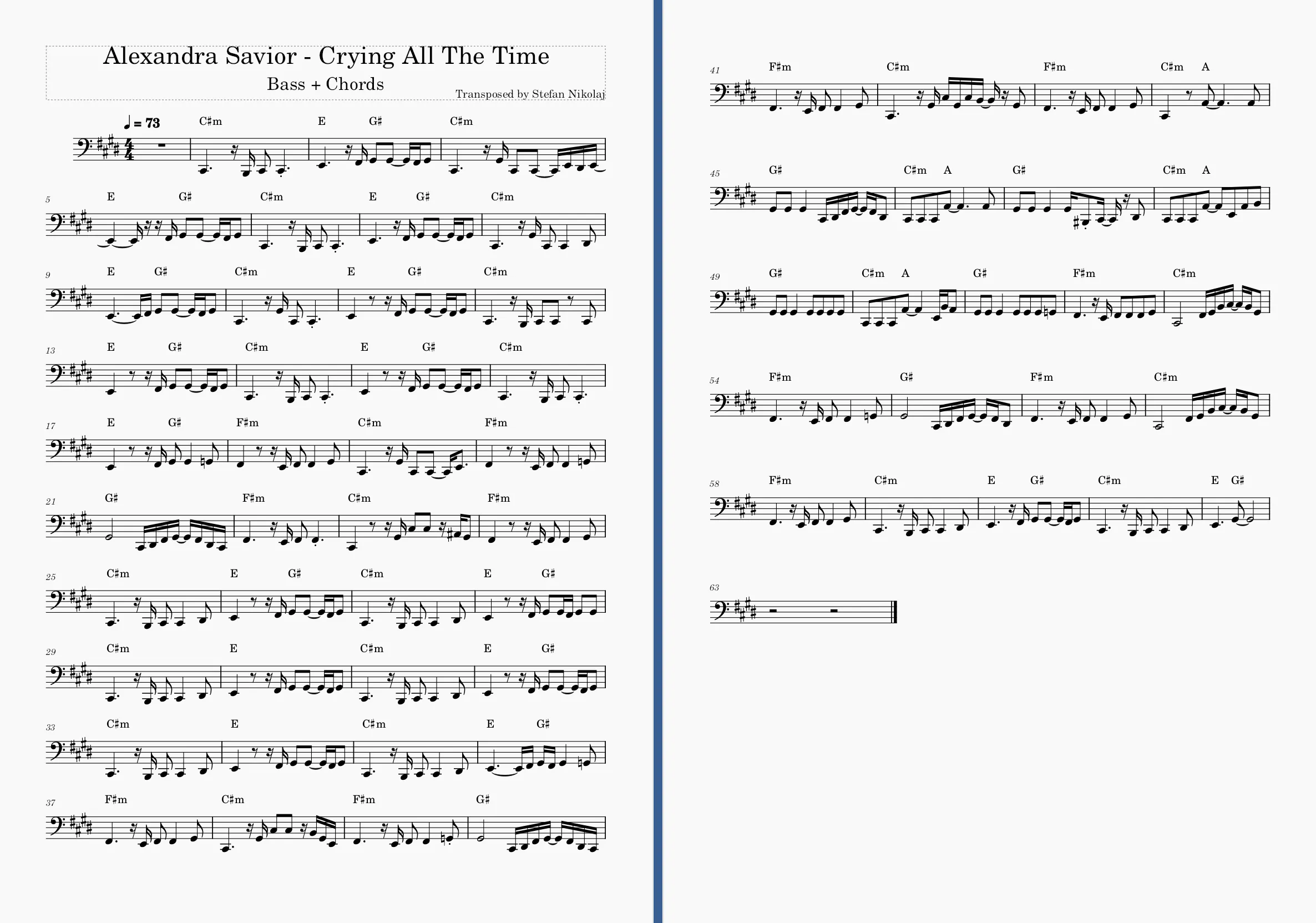A very dear friend of mine has a really cool playlist from where I found some really cool songs I hadn’t known before. One of the songs, towards the bottom, is Alexandra Savior’s Crying All The Time. At first I didn’t want to listen to it – it looked like it’s just moody white girl bedroom pop (and it basically is), but one day while leaving the playlist on shuffle it reached the song. There’s a cool synthesizer at the beginning which made me not skip it, and then I heard the bass line – wow! After listening to it a couple more times, I realized that this is a damn good song, and interesting to me from a compositional perspective. So, in this article, let’s take a look at the composition a bit. Just be warned, I have never taken music lessons, neither do I play bass guitar (though I’d love to). Still, I know what I’m talking about.

First, let’s start with the transcription. There are no bass tabs of the song online, which is a shame. Only some good tabs on Ultimate Guitar which show the chords. Still, to transcribe the bass, I decided to use my own ear and a low-pass filter to only hear the bass part. I managed to almost reach the end once, then my program crashed and I lost all progress, however the next day I continued and finished it quickly in MuseScore.
One interesting thing I noticed with the bass was that the bass lines for almost every line differed slightly. The same motifs were repeated throughout the song, however every time they would be changed and this makes the bass sound quite dynamic and drew me to the song initially. The bass mostly plays the root notes of each chord, with a few bass runs interspersed, but it’s the fills which make it interesting. Also, the small dynamic change on bar 47 in the sheet music is lovely.
You can listen to the MIDI version which has the chords and the bass: Download!
The song is in the key of C# minor with a tempo of 73bpm and it follows a Verse – Chorus – Verse – Bridge – Chorus – Verse structure which all have their own chord progressions:
Verse – C#m E G# (i-i-III-V)
Chorus – F#m C#m F#m G# (iv-i-iv-V)
Bridge – C#m A G# (i-VI-V-V)
The i-V movement is the main contributor to the emotional tension and release in the song. Though the major V chord (G#) is not part of the C# minor scale (because of the raised seventh) it gets used very often in all genres – try finding famous Yugoslav pop rock songs without it! Basically, just the interaction between the raised seventh (C) and the tonic (C#) makes the ending of the chord loop satisfying. The VI-V in the bridge with significant change in the drums makes the upcoming second chorus even more impactful. One final part that is interesting is how every chorus ends on a C#m which then very smoothly leads into the verses again, which I like. There are also other interesting parts of the song, but I am not a music theorist so I can’t explain them that well. Still, the song sounds nice.
Another contributor to the atmosphere is the instrumentation and vocals. The arrangement has a synth, a guitar, a bass guitar and drums, with vocals. Well, I’m not sure if it’s a synth at all, since the live versions have the synth-y sounds done with a guitar and tons of guitar pedals but it can be done with a synth as well, and in the live versions there is one, even though it’s just a simple Nord Electro 4. The lead guitar’s sound is mainly shaped by the overdrive and tremolo, as well as some chorus and other effects – the live version has some impressively-large pedalboards! The vocals reminded me of Amy Winehouse (fellow moody white girl pop artist), and they do attempt to imitate the 60s-vocal-reverb sound. In effect, it’s like an overdrive and reverb effect applied to the vocals, which sounds pretty cool to me. There are also background vocals which add to the effect. Overall, it’s a good song.
Download the PDF version of the transcription here: Download!